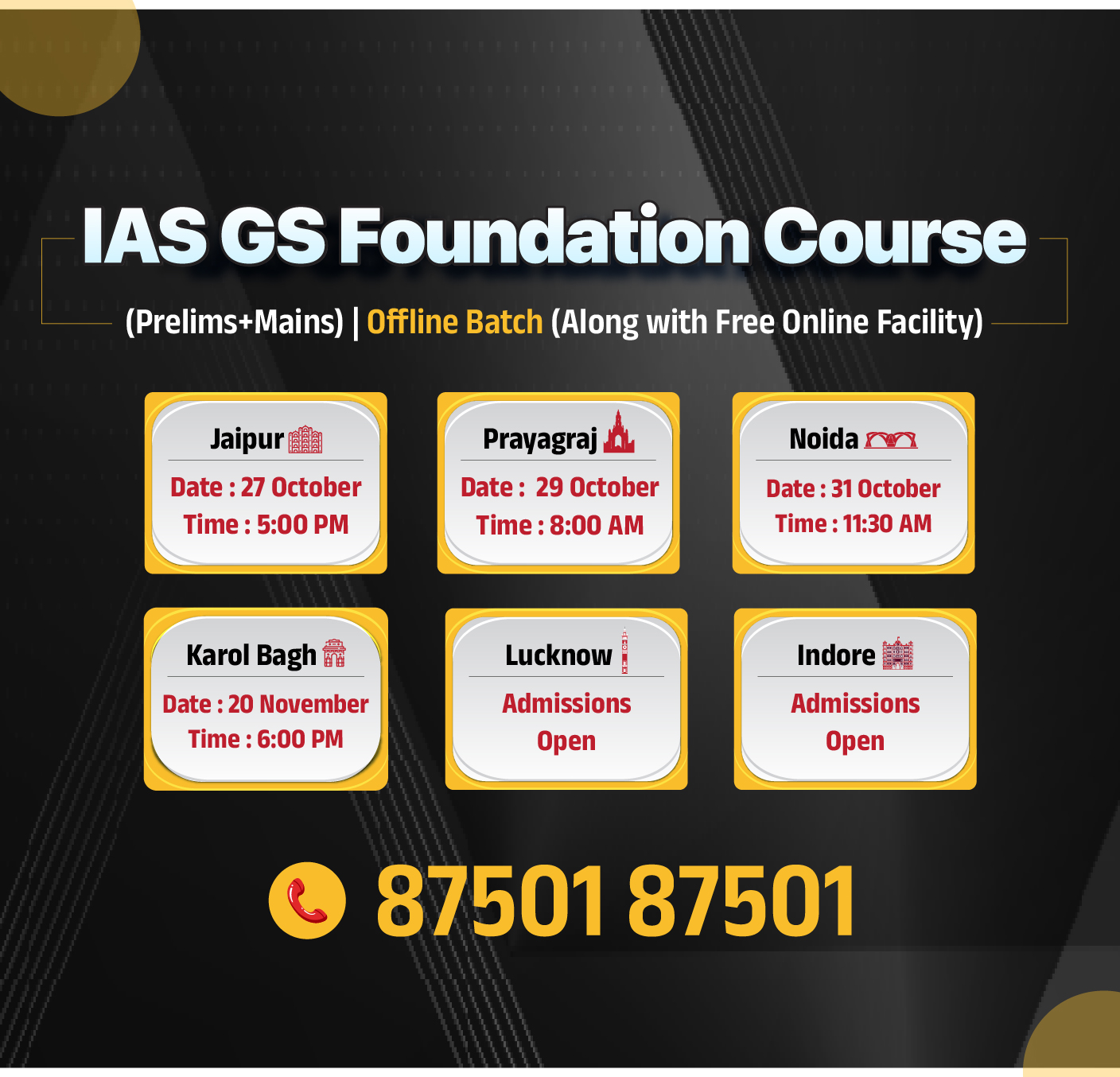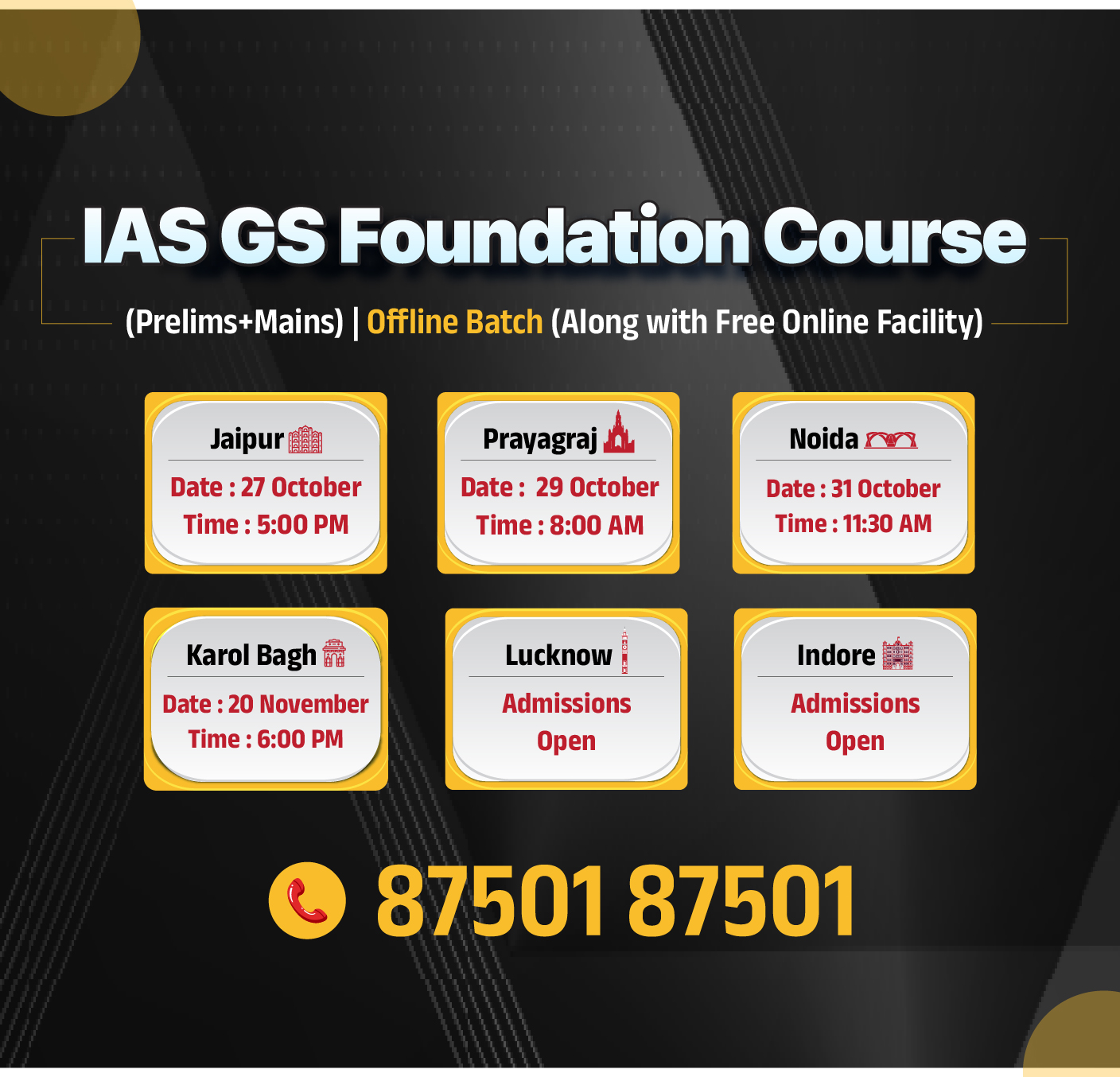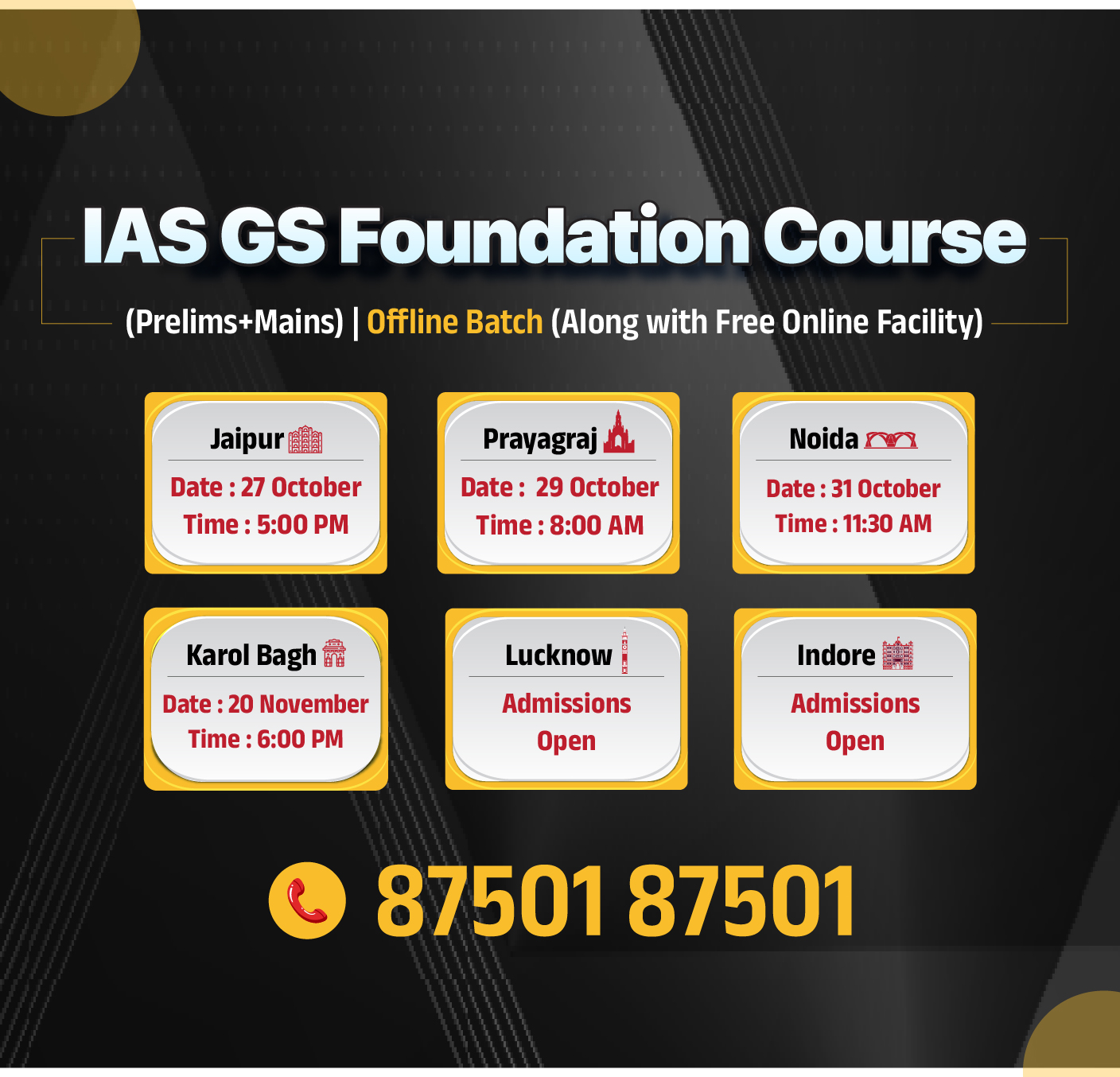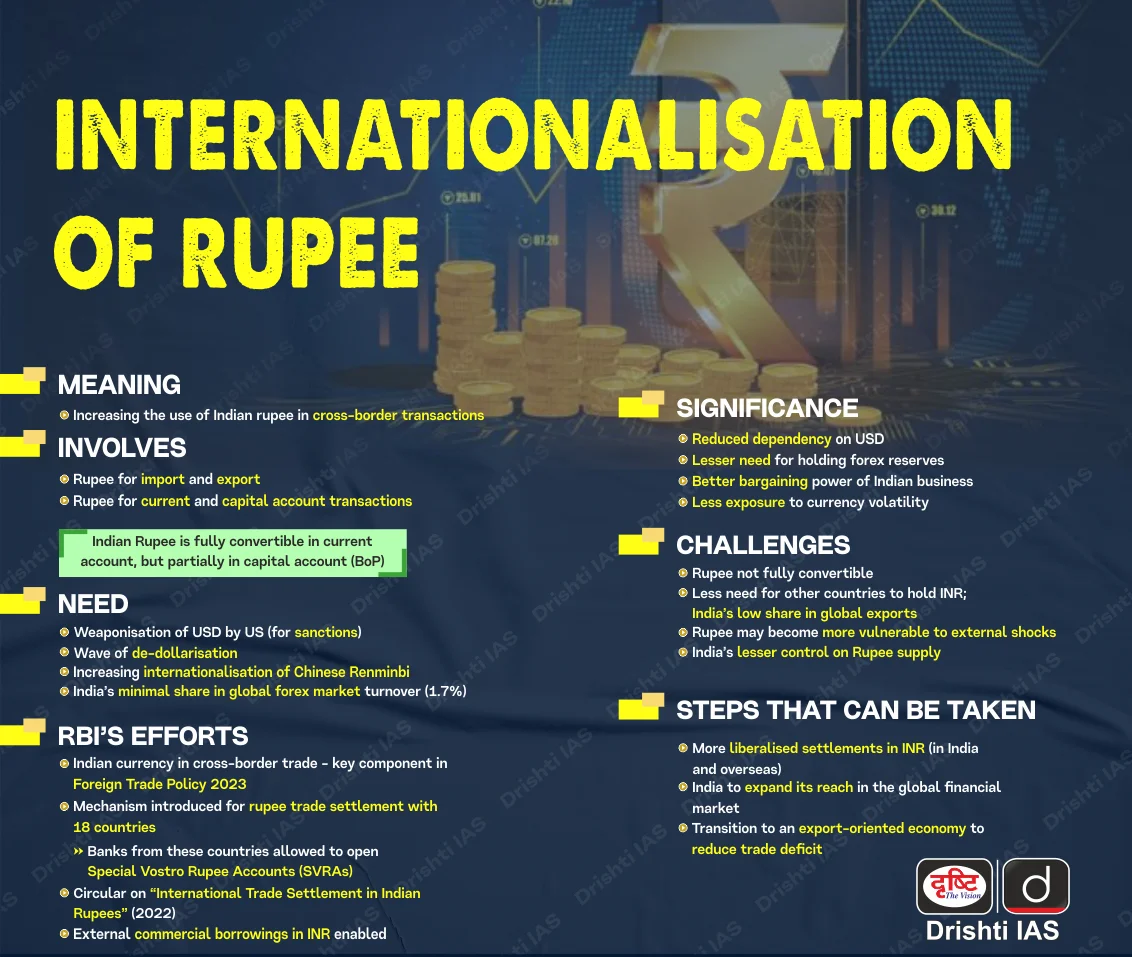Disaster Management
Strengthening India’s Disaster Resilience
For Prelims: National Disaster Management Authority, Wetlands, Mausam, Coalition for Disaster Resilient Infrastructure
For Mains: Disaster Management in India, Key Disaster Challenges Undermining India’s Resilience and Preparedness.
Why in News?
India is enhancing disaster resilience through science-based, nature-driven, and finance-linked strategies, guided by the Prime Minister’s 10-Point Agenda on Disaster Risk Reduction (DRR) (2016).
- The 15th Finance Commission’s Rs 2.28-lakh-crore allocation (2021–26) for DRR strengthens this shift from reactive relief measures to proactive, anticipatory governance in disaster management.
How is India Enhancing Disaster Risk Reduction (DRR) to Mitigate Hazards?
- Institutional Framework: The Home Ministry and the National Disaster Management Authority (NDMA) guide states through multi-hazard planning, using frameworks such as the National Guidelines for Landslides (2023) and the Urban Flood Management Framework (2024) to standardize preparedness and response measures.
- 10-Point Agenda on DRR: Prime Minister’s 10-Point Agenda integrates DRR into development, uses technology, and strengthens local capacities, covering community preparedness, tech-driven solutions, and global cooperation.
- Financial Innovation: The 15th Finance Commission allocated Rs 2.28 lakh crore (2021–26) across preparedness (10%), mitigation (20%), response (40%), and reconstruction (30%), reducing reliance on multilateral loans.
- Reconstruction packages worth Rs 5,000 crore have already been approved for states like Uttarakhand, Himachal Pradesh, Assam, Sikkim, and Kerala.
- Nature-Based Solutions: India focuses on sustainable, ecosystem-based interventions.
- Initiatives include bio-engineering for slope stabilization, restoring wetlands to control floods, creating fuel-breaks to prevent forest fires, and enhancing urban green spaces.
- Technological Measures: NDMA integrates advanced technologies such as remote sensing, site-specific automated weather stations, and glacial-lake monitoring to improve risk prediction.
- Hazard mapping and early-warning systems ensure timely alerts to vulnerable communities.
- Mobile applications like FloodWatch, Mausam, Meghdoot, and Damini (for lightning) provide real-time, actionable alerts to citizens and farmers, enhancing community readiness.
- Programs like the National Cyclone Mitigation Programme (2011–22) have built early-warning systems and 700 cyclone shelters across 8 states.
- Capacity Building: Geo-spatial training labs are being established, and the National Institute of Disaster Management (NIDM) has expanded courses covering 36 streams of disaster management.
- Volunteer networks like Apda Mitra and Yuva Apda Mitra train 2.5 lakh citizens in disaster preparedness. At grassroots level, panchayats and schools run local DRR plans and safety drills
- Together, these efforts enhance behavioural readiness and empower communities to respond effectively during emergencies.
- International Coordination: India engages globally through initiatives like the Coalition for Disaster Resilient Infrastructure and participates in DRR discussions in the G-20, BIMSTEC, and Indian Ocean Rim Association, sharing expertise and learning best practices for multi-hazard resilience.
What are the Key Challenges in India’s Disaster Resilience?
- Mnemonic: “FRAGILE”
- F- Fragile Ecosystems and Cascading Disasters: Himalayan and northeastern regions face compound disasters, where cloudbursts trigger landslides, which in turn cause flash floods.
- Unchecked infrastructure and climatic variability amplify risks as seen in the 2023 Himachal, Uttarakhand, and Sikkim GLOF events.
- R - Reactive and Relief-Centric Governance: Disaster policy still focuses on post-event relief instead of pre-emptive mitigation.
- A- Administrative and Institutional Weaknesses: Disaster management is over-centralised, leaving districts under-resourced and poorly trained.
- Coordination gaps and slow fund flow undermine local-level preparedness and quick response
- G - Governance Failures and Urban Mismanagement: Unplanned urbanisation and weak regulation have crippled natural drainage, causing chronic flooding.
- Over 80% of Indians now live in high-risk districts due to poor land-use enforcement.
- I - Inadequate Technology and Early Warning Systems: Only 25% of flood-risk districts have functional forecasting limiting last-mile reach.
- L - Lax Enforcement of Building Codes: Despite 59% of India being quake-prone, compliance with the National Building Code remains poor.
- Informal construction and unsafe land use heighten structural vulnerability in cities and towns.
- E - Expanding Socio-Economic Vulnerability: Poverty and inequality push people into unsafe, marginal lands with minimal protection. Informal workers bear high climate losses.
What Should be the Road Ahead for India’s Disaster Resilience?
- Mnemonic: “RESILIENT”
- R - Risk-informed Planning: Integrate disaster risk in budgets, enforce floodplain zoning and restrict high-risk settlement development. Invest in Nature-Based Solutions like wetlands and mangroves.
- E- Early Warning & Technology Upgrades: Deploy hyper-local Multi-Hazard Early Warning Systems, use IoT micro-sensors for river, slope, soil monitoring and deliver geo-tagged alerts via Common Alerting Protocol (CAP) to mobiles.
- S- Strengthening Infrastructure: Enforce disaster-resilient construction codes and retrofit pre-2005 critical infrastructure. Integrate climate-risk in infrastructure planning
- I- Inclusive Community Preparedness: Empower District Disaster Management Authorities with legal autonomy, and expert staff. Mandate village/ward contingency plans in first response.
- L - Local Capacity Building: Decentralise resources and decision-making; improve local training and readiness.
- I -Institutional Coordination: Integrate private sector surge capacity beyond mere Corporate Social Responsibility (CSR) and conduct inter-agency drills; coordinated response.
- E- Economic Readiness: Expand disaster insurance and dedicated resilience funds and impose strict penalties for non-compliance to support disaster mitigation.
- N - Nature-Based Solutions: Restore mangroves, wetlands, forests; integrate into urban planning to buffer disasters.
- T - Training: Train 1 million women as ‘Aapda Sakhi’ and establish trauma and critical care centers with trained healthcare staff to provide Psychological First Aid.
Conclusion
India’s disaster resilience remains FRAGILE, but adopting the RESILIENT approach focusing on planning, early warning, infrastructure, community, local capacity, nature-based solutions, and training can strengthen preparedness, reduce losses, and support Sustainable Development Goals (SDGs) and lead India on the path to a resilient nation by 2047.
|
Drishti Mains Question: Examine the major challenges that undermine India’s disaster resilience and preparedness. |
Frequently Asked Questions (FAQs)
1. What is India’s primary disaster management body?
The National Disaster Management Authority (NDMA) coordinates pre- and post-disaster management and guides states on multi-hazard planning.
2. What are some nature-based disaster mitigation initiatives?
Wetland restoration, slope bio-engineering, fuel-breaks, and urban green spaces.
3. How is technology used in disaster management?
Remote sensing, automated weather stations, glacial monitoring, and hazard mapping enhance risk prediction.
4. Which mobile apps provide real-time disaster alerts?
FloodWatch, Mausam, Meghdoot, KISAN, and Damini alert citizens and farmers.
UPSC Civil Services Examination Previous Year Question (PYQ)
Mains:
Q. Discuss the recent measures initiated in disaster management by the Government of India departing from the earlier reactive approach. (2020)
Q. Vulnerability is an essential element for defining disaster impacts and its threat to people. How and in what ways can vulnerability to disasters be characterized? Discuss different types of vulnerability with reference to disasters. (2019)
Q. Describe various measures taken in India for Disaster Risk Reduction (DRR) before and after signing ‘Sendai Framework for DRR (2015-30)’. How is this framework different from ‘Hyogo Framework for Action, 2005’? (2018)


International Relations
India-Qatar Trade and Economic Cooperation
For Prelims: Qatar, Comprehensive Economic Partnership Agreement, Unified Payments Interface, LNG Supply Agreement, FDI, Za’ir-Al-Bahr, National Infrastructure Pipeline, ISRO.
For Mains: India-Qatar Strategic Partnership: Analyzing Mutual Importance, Economic Synergy, and Future Trajectories in West Asian Geopolitics.
Why in News?
The Union Minister of Commerce and Industry visited Qatar, to co-chair the India-Qatar Joint Commission on Economic and Commercial Cooperation, focusing on boosting bilateral trade and exploring new economic opportunities.
What are the Key Outcomes of the India-Qatar Joint Commission Meeting?
- Ambitious Trade Target: Both countries recognized the untapped potential and emphasised the goal of doubling bilateral trade by 2030. Current trade stands at approximately USD 14 billion.
- Both nations reaffirmed their commitment to pursuing an ambitious India-Qatar Comprehensive Economic Partnership Agreement (CEPA), a free-trade pact.
- Digital Integration: A key milestone was the launch of India's Unified Payments Interface (UPI) in Qatar, facilitating seamless digital payments for the Indian diaspora and local consumers.
- Sectors Identified for Growth: The ministers highlighted sectors to boost Indian exports and collaborations:
- Traditional: Pharmaceuticals, textiles, gems & jewellery
- Manufacturing & Tech: Electronics, automobiles, processed foods
- Future-Focused: IT, emerging high-tech industries, solar energy.
- Energy Security Reinforced: India appreciated Qatar's long-term LNG supply agreement of 7.5 million tonnes per year from 2028, a cornerstone of the energy partnership.
How is the Partnership between India and Qatar Reflected Across Sectors?
- Trade Ties: India-Qatar trade reached USD 14.15 billion in FY25, with a USD 10.78 billion trade deficit for India driven mainly by petroleum imports (89%).
- India ranks among Qatar’s top three export destinations and top three import sources.
- Investment: Over 20,000 Indian companies operate in Qatar (wholly owned and joint ventures), while Qatar’s FDI in India has grown to about USD 1.5 billion.
- Energy Supply: Qatar is India’s largest LNG and LPG supplier (26% of India’s LPG imports). In FY 2024–25, hydrocarbon trade made up 78.7% of total bilateral trade, with the 25-year LNG supply pact starting from 2028.
- Defense Relations: The India-Qatar Defence Cooperation Agreement, signed in 2008 and extended in 2018, covers training, naval visits, DIMDEX participation, and the bilateral maritime exercise Za’ir-Al-Bahr (Roar of the Sea).
- Cultural Relations: Regular cultural exchanges occur under the 2012 Cultural Cooperation Agreement. 2019 was marked as the India-Qatar Year of Culture, India was a partner for Qatar-MENASA 2022, and the ‘Passage to India’ festival was held in 2024.
- Over 830,000 Indians in Qatar reflect the strong people-to-people ties between the two nations.
What is the Significance of India-Qatar Relations?
India's Significance for Qatar
- Guaranteed Energy Market: India, as a large and reliable LNG buyer, gives Qatar a stable revenue stream supporting its economy and Qatar National Vision 2030.
- Source of Essential Goods: India supplies Qatar with food, pharmaceuticals, and manufactured goods, making it vital for Qatar’s supply chain and food security.
- Non-Energy Economic Diversification: India offers Qatar investment opportunities beyond hydrocarbons in fintech, renewable energy, and digital infrastructure, while space technology (ISRO) and affordable healthcare provide new collaboration avenues.
- Logistics & Project Execution: Indian companies lead in engineering, procurement, and construction (EPC), executing mega-projects like the FIFA World Cup 2022, while the large Indian workforce supports Qatar’s healthcare, education, hospitality, and aviation sectors.
- Partner in Knowledge & Digital Economy: India’s IT and software expertise drives Qatar’s digital transformation, while education and skill development offer models for Qatar’s knowledge-based economy.
Qatar's Significance for India
- Energy Security & Price Stability: Qatar, a price-setter in the LNG market, offers long-term contracts that shield India from price volatility and support its strategic gas reserves and clean energy transition.
- Remittances: With over 800,000 Indians, Qatar hosts a large diaspora that provides billions in remittances, supporting India’s foreign exchange and family livelihoods.
- Strategic Investment Source: The Qatar Investment Authority (QIA, Qatar's sovereign wealth fund) has invested billions in India across infrastructure, technology, and real estate, acting as a key patient capital source for projects like the National Infrastructure Pipeline (NIP).
- Strategic Depth in West Asia: Qatar’s mediator role (e.g., in Afghanistan) and the Al-Udeid Air Base with its US ties provide India a strategic diplomatic advantage in the region.
|
Click Here to Read: Challenges in India-Qatar Bilateral Relations Click Here to Read: Way Forward |
Conclusion
India-Qatar relations are multifaceted, combining trade, energy, investment, defense, and cultural cooperation. With a shared vision of doubling trade by 2030, strategic LNG supply agreements, digital integration via UPI, and strong diaspora ties, both nations are leveraging complementary strengths to foster sustainable economic growth and regional stability.
|
Drishti Mains Question: Assess the role of digital integration, trade diversification, and sectoral cooperation in strengthening India-Qatar bilateral ties. |
Frequently Asked Questions (FAQs)
1. What is the status of India-Qatar bilateral trade?
Bilateral trade reached USD 14.15 billion in FY25, with India facing a trade deficit of USD 10.78 billion due to petroleum imports.
2. How does Qatar contribute to India’s energy security?
Qatar provides long-term LNG supply agreements (7.5 million tonnes/year from 2028), stabilizing prices and supporting India’s clean energy transition.
3. What measures are being taken to address India's trade deficit with Qatar?
Key measures include diversifying exports into pharmaceuticals, automobiles, and IT, pursuing a CEPA to reduce barriers, and promoting investments from the Qatar Investment Authority (QIA).
UPSC Civil Services Examination, Previous Year Question
Prelims
Q. Which of the following is not a member of ‘Gulf Cooperation Council’? (2016)
(a) Iran
(c) Oman
(b) Saudi Arabia
(d) Kuwait
Ans: (a)
Mains
Q. The question of India’s Energy Security constitutes the most important part of India’s economic progress. Analyse India’s energy policy cooperation with West Asian countries. (2017)


Facts for UPSC Mains
Credit Reforms to Deepen Financial Markets
Why in News?
The Reserve Bank of India (RBI) announced a set of credit reforms to deepen financial markets, enhance the role of banks in corporate consolidation, and advance rupee internationalisation, amid rising trade tensions with the US and renewed BRICS currency discussions on alternatives to the US dollar.
What are the Key Credit Reforms Announced by RBI?
- Finance Mergers and Acquisitions (M&As): For the first time, banks in India can lend directly for corporate takeovers (earlier dominated by Non-Banking Financial Companies (NBFCs) and private funds), a domain previously restricted due to concerns over misuse, promoter risk, and credit concentration.
- Rupee-Denominated Lending: Indian banks can now lend in rupees to neighbours like Nepal, Bhutan, and Sri Lanka.
- This move aims to reduce dollar dependence in regional trade and settlements, provide rupee liquidity, and promote the internationalisation of the rupee while strengthening India’s monetary influence.
- Increasing Capital Market Lending Limits: The loan limit against shares has been raised to Rs 1 crore (from Rs 20 lakh), and Initial Public Offering (IPO) financing limit increased to Rs 25 lakh (from Rs 10 lakh).
- These measures aim to improve access to market-based financing and energise primary capital markets.
- Use of SRVA in Corporate Debt: Funds in Special Rupee Vostro Accounts (SRVAs), can now be invested in corporate bonds and commercial papers, not just government securities.
- It strengthens rupee liquidity and deepens India’s bond market.
- Expanded Currency Benchmarks: The Financial Benchmarks India Limited (FBIL) will include more partner currencies beyond USD, Euro, Pound, and Yen. It enables direct forex quotes with more countries and reduces dollar dependence.
- Revised Basel III Capital Norms: From April 2027, RBI will implement revised Basel III capital adequacy norms for commercial banks.
- The new standards are expected to reduce capital requirements for certain sectors, particularly MSMEs and residential real estate loans, by introducing lower risk weights for these sectors.
- This aims to boost banks' capital adequacy ratios while maintaining financial stability.
Financial Markets in India
- About: Financial markets are platforms where securities like stocks, bonds, and currencies are traded.
- These markets, including forex, bond, stock, money, and derivatives markets, play a crucial role in a country's economic growth.
- Components of Financial Markets in India:
- Money Market: Deals with short-term financial instruments (less than one year), facilitating borrowing and lending between banks and financial institutions.
- Capital Markets: Involves long-term instruments (over one year). It includes the primary market (new securities) and secondary market (existing securities).
- Foreign Exchange Market: Facilitates currency trading, crucial for international trade and investment.
- Derivatives Market: Involves trading instruments like options and futures that derive value from underlying assets.
- Importance of Financial Markets: It supports capital raising, risk management, and contributes to economic stability and growth. They are essential for businesses, investors, and overall economic development.
- A failure in these markets can lead to recession and unemployment.
What are the Implications of the Credit Reforms by RBI?
- Enhanced Capital Access: By allowing banks to fund takeovers, corporates now have access to low-cost, structured finance for scaling operations.
- However, this also increases exposure to promoter risk and demands enhanced credit appraisal, monitoring, and governance safeguards to prevent asset quality deterioration.
- Corporate Sector Empowerment: Easier access to structured bank finance enables well-governed companies to undertake strategic expansions and sectoral consolidation.
- This is likely to catalyse growth in key sectors like infrastructure, energy, logistics, and manufacturing, improving global competitiveness.
- Rupee Internationalisation: Allowing rupee-denominated loans to neighbours positions India as a regional financial anchor. These reforms serve as a counterweight to global currency blocs, offering a practical alternative through rupee-based trade and credit.
- Enabling investments of surplus SRVA balances into Indian corporate bonds further builds international confidence in Indian markets and deepens rupee liquidity abroad.
Click here to Read: Internationalization of Rupee
|
Drishti Mains Question: Critically evaluate the role of Reserve Bank of India (RBI) in strengthening India’s financial markets and promoting global competitiveness |
Frequently Asked Questions (FAQs)
1. What new lending freedom has RBI given to banks?
Banks can now finance mergers and acquisitions (M&As), a space earlier dominated by NBFCs.
2. How do rupee-denominated loans to neighbours help India?
They promote rupee internationalisation and reduce dollar dependence in regional trade.
3. What new use is allowed for Special Rupee Vostro Accounts (SRVAs) balances?
Surplus SRVA funds can now be invested in corporate bonds and commercial papers.
UPSC Civil Services Examination, Previous Year Questions (PYQs)
Prelims
Q. Convertibility of rupee implies (2015)
(a) being able to convert rupee notes into gold
(b) allowing the value of rupee to be fixed by market forces
(c) freely permitting the conversion of rupee to other currencies and vice versa
(d) developing an international market for currencies in India
Ans: (c)
Mains
Q. Do you agree with the view that steady GDP growth and low inflation have left the Indian economy in good shape? Give reasons in support of your arguments? (2019)


Important Facts For Prelims
Nobel Prize in Chemistry 2025
Why in News?
The Royal Swedish Academy of Sciences has decided to award the Nobel Prize in Chemistry 2025 to Susumu Kitagawa (Japan), Richard Robson (Australia), and Omar Yaghi (US) for their groundbreaking work in creating Metal-Organic Frameworks (MOFs).
What are the Key Highlights of the Nobel Prize in Chemistry 2025?
Creation of Metal–organic Frameworks (MOFs):
- Richard Robson: He was among the first to design 3D structures by combining metal ions (like copper) with organic molecules to form strong, interconnected frameworks.
- He showed that it is possible to make materials with big spaces inside, which could trap molecules, which laid the groundwork for the creation of porous materials.
- Susumu Kitagawa: Building on Robson's work, Kitagawa discovered that porous structures could not only remain stable but also expand and contract based on surrounding gases or chemicals.
- This breakthrough made them adaptable for gas capture (e.g., carbon dioxide) and energy storage.
- Omar Yaghi: He coined the term Metal-Organic Frameworks (MOFs) for porous structures and developed reticular chemistry (systematic approach to assembling metal ions and organic molecules into large, ordered structures).
- Metal–Organic Frameworks (MOFs) are a class of crystalline materials made by linking metal ions with organic molecules. They form porous, sponge-like structures with tiny, well-organized holes (pores) that can trap, store, or filter gases and chemicals.
- Omar Yaghi showed that MOFs could be rationally designed for new properties.
Significance of MOFs
- Water harvesting: MOFs can extract water from desert air.
- Carbon capture: Certain MOFs can selectively attract and store carbon dioxide, helping combat climate change.
- Storage of toxic gases: MOFs can safely trap harmful chemicals for later use or disposal.
- Custom-designed Chemical Processes: MOFs can be engineered for specific chemical reactions or storage needs, thanks to their highly customizable structures.
Indian Nobel Laureate in Chemistry: In 2009, Venkatraman Ramakrishnan (India), along with Thomas A. Steitz (US) and Ada E. Yonath (Israel), was jointly awarded the Nobel Prize in Chemistry "for studies of the structure and function of the ribosome."
|
Click here to Read: Nobel Prize in Physiology or Medicine 2025 |
Frequently Asked Questions (FAQs)
1. What are Metal–Organic Frameworks (MOFs)?
MOFs are crystalline materials made by linking metal ions with organic molecules, forming porous structures that can store, trap, or filter gases and chemicals.
2. Who won the Nobel Prize in Chemistry 2025 and for what discovery?
Susumu Kitagawa, Richard Robson, and Omar Yaghi won for creating Metal–Organic Frameworks (MOFs), revolutionizing molecular architecture and material chemistry.
3. What is Reticular Chemistry?
Reticular Chemistry is a systematic approach to assembling metal ions and organic linkers into ordered 3D structures like MOFs for customized functions.
4. What are the key applications of MOFs?
MOFs are used for carbon capture, water harvesting, toxic gas storage, and clean energy applications, contributing to climate change mitigation and sustainable technologies.
UPSC Civil Services Examination, Previous Year Questions (PYQs)
Prelims
Q. What is blue carbon? (2021)
(a) Carbon captured by oceans and coastal ecosystems
(b) Carton sequestered in forest biomass and agricultural soils
(c) Carbon contained in petroleum and natural gas
(d) Carbon present in atmosphere
Ans: (a)
Q. Consider the following agricultural practices: (2012)
- Contour bunding
- Relay cropping
- Zero tillage
In the context of global climate change, which of the above helps/help in carbon sequestration/storage in the soil?
(a) 1 and 2 only
(b) 3 only
(c) 1, 2 and 3
(d) None of them
Ans: (b)


Rapid Fire
IAF to Receive First Tejas Mk1A Fighter Jet
The Indian Air Force (IAF) is set to receive its first Light Combat Aircraft (LCA) Tejas Mk1A, marking a significant milestone in India’s indigenous fighter jet programme.
Tejas Mk1A
- About: The Tejas Mk1A is an upgraded variant of India’s Light Combat Aircraft (LCA) Tejas, developed by Hindustan Aeronautics Limited (HAL).
- Purpose: This version is aimed to enhance operational and combat capabilities, survivability and maintainability over the baseline Mk1.
- Capabilities:
- Active Electronically Scanned Array (AESA) radar integration.
- Electronic Warfare Suite (EWS) — radar‑warning and self‑protection jamming.
- Upgraded Flight Control Computer (DFCC Mk1A) for better maneuverability and stability.
- Missile compatibility- Beyond Visual Range (BVR) missiles, Air-to-Air and Air-to-Ground missiles and Advanced Short Range Air-to-Air Missiles (ASRAAM).
- Planned integration of Combined Interrogator and Transponder (CIT), Software Defined Radio (SDR) and Operating Data Link (ODL) with existing onboard avionics.
LCA Tejas
- About: The LCA Tejas programme, initiated by the Government of India in 1984, aimed to replace the ageing MiG-21 fighter jets. The programme is managed by the Aeronautical Development Agency (ADA).
- Features:
- Lightest, smallest, and tailless multi-role supersonic fighter in its class.
- Capable of carrying a variety of air-to-air, air-to-surface, and precision-guided weapons.
- Maximum payload capacity of 4000 kg.
- Maximum speed: Mach 1.8.
- Range: 3,000 km.
- Variants of Tejas:
- Tejas Trainer: 2-seater operational conversion trainer for training air force pilots.
- LCA Navy: Twin- and single-seat carrier-capable for the Indian Navy.
- LCA Tejas Navy MK2: This is phase 2 of the LCA Navy variant.
- LCA Tejas Mk-1A: This is an improvement over the LCA Tejas Mk1 with a higher thrust engine.
| Read More: India’s 5G Fighter Aircraft and LCA Tejas |


Place In News
Port of Pasni
Pakistan has reportedly offered the US to build a port at Pasni, near Gwadar in Balochistan, giving Washington potential maritime access close to Iran’s border.
- The Pasni port proposal aims to reduce Pakistan’s reliance on China’s Belt and Road Initiative (BRI), attract US investment, and export critical minerals.
- Strategic Location: The Port of Pasni located on the Arabian Sea is a small deep-water harbour in Balochistan’s Gwadar district, featuring a fish harbour, and a Pakistan Maritime Security Agency (PMSA) base.
- Port of Pasni lies near the Iran-Pakistan border, east of China-backed Gwadar Port, and close to India’s Chabahar Port, forming a key strategic maritime triangle linking Chabahar (India-Iran), Gwadar (China-Pakistan), and Pasni (US-Pakistan).
- Strategic Significance: The rich mineral deposits in the region, especially those related to rare earth mining rights, add an economic layer to the strategic importance of the Port of Pasni.
- Meanwhile, China's involvement in Gwadar Port under the China–Pakistan Economic Corridor (CPEC), could bring rival superpowers into close proximity, escalating the strategic rivalry in the region.
- The Pasni–Gwadar–Chabahar triangle could become a new geopolitical hotspot, intertwining maritime security, energy routes, and great power rivalry.
- This move could undermine India’s Chabahar Port project, which provides a trade route to Afghanistan and Central Asia bypassing Pakistan. The US withdrawal of the Chabahar sanctions waiver further complicates India’s role.
| Read more: Iran, Pakistan, and the Baloch Militancy |


Rapid Fire
Finger Lakes
Scientists are investigating newly discovered craters at the bottom of Seneca Lake (one of the Finger Lakes) to determine if they release methane or other gases responsible for the mysterious "Seneca Guns" sounds.
- Seneca Lake, one of New York’s Finger Lakes, is famous for its mysterious booming sounds, popularly called the Seneca Guns or Seneca Drums.
Finger Lakes
- About: The Finger Lakes comprise 11 long, narrow, parallel lakes in north-south orientation, named for their finger-like shape on the map.
- The two largest finger lakes, Seneca and Cayuga, are among the deepest in North America.
- Geological Formation: They were created when advancing glaciers during the Pleistocene ice age deepened and widened narrow, V-shaped river valleys into U-shaped troughs through a process called glacial scouring.
- Moraines (rock and debris piles) mark the glacier's limits at the southern ends of the lakes, while drumlins (teardrop-shaped hills) formed under the moving ice and appear in bands north of the lakes.
- Role of Milankovitch Cycles: These glacial advances and retreats were driven by long-term orbital variations in global climate, known as Milankovitch cycles.
- Formation of Lake Basins: The eventual retreat of the glaciers left behind debris piles called recessional moraines, which acted as dams, causing the deepened valleys to fill with water and form the modern lakes.
| Read More: Landforms Part-II |


Rapid Fire
INS Sutlej
INS Sutlej arrived at Port Louis to conduct the 18th Joint Hydrographic Survey in Mauritius.
- INS Sutlej is a specialized hydrographic survey vessel of the Indian Navy, built by Goa Shipyard Limited and commissioned in 1993. Currently based in Kochi under the Southern Naval Command.
- It is a specialized hydrographic survey vessel for charting, mapping, and oceanographic research.
- It is equipped with advanced systems including:
- Multi-beam swath echo sounder and side-scan sonars – for high-precision seabed mapping.
- Differential GPS and motion sensors – for navigational accuracy.
- Sea gravimeter, magnetometer, and oceanographic sensors – for geophysical and environmental data.
- Automated data logging system – for real-time digital survey processing.
- Carries one Chetak helicopter and four survey motorboats, augmenting reconnaissance and data-gathering reach.
- Standards: Conforms to ISO 9002 digital survey accuracy standards, enabling production of electronic navigational charts (ENCs).
| Read More: India-Mauritius Relations |













